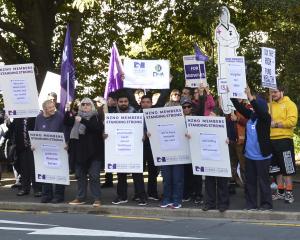In February, 42.6% of births at the hospital were by Caesarean section, while the hospital aims to have a rate no higher than 28%. In February last year the rate was 37.4%.
Ms Humphries said an analysis of three months' data showed there was no area of concern.
Further evaluation of earlier records was to be carried out to see if these results were replicated.
In hindsight, the decision-making was " very timely" and it was "very rarely" that anyone could say in any particular case "we should have waited a couple of hours".
Ms Humphries said when looking at the rate it was important to consider it not in isolation, but in the context of the level of complexity of the cases involved.
While there had been concern expressed from time to time in the past few years about the rate, Ms Humphries said it was quite variable month-to-month.
Among factors influencing the high rate were the age of first-time mothers and the number of fertility-assisted births.
The latter could result in a more conservative approach to the management of labour.
Ms Humphries said she felt women were given adequate information about the risks related to Caesarean sections.
These included the risk of bladder damage, haemorrhage and the potential for uterine rupture in future pregnancies. There were also risks with any anaesthetic procedures.
Mothers whose babies were delivered by Caesarean also took much longer to recover than someone who had a normal vaginal birth.
Ms Humphries said while some births at the hospital would be set down for a particular time and therefore classed as elective surgery, there would still be clinical reasons for such operations.
It was not a matter of women choosing when they wished to give birth.
She did not have a comparison in costs of the two types of delivery, but a normal vaginal birth would be much less expensive.
The average length of hospital stay alone would be three to four days for a Caesarean, compared with two or three days for a vaginal birth.
More work was needed to see how Dunedin Hospital's rate compared with other areas and with Australia. Good benchmarking information was needed.
Ministry of Health maternity services senior adviser Bronwen Pelvin, in an email response to questions, said the ministry was working on a set of national clinical indicators including Caesarean section rates against which all district health boards would be monitored.
This would allow them to see how they compared with other boards and assist them to identify areas of clinical practice where they could "make improvements to the outcomes for women and their babies".
There was no consensus in New Zealand regarding the optimal Caesarean section rate to "achieve the best health outcomes".
However, there was consensus that the current rate was higher than that recommended by the World Health Organisation.
In 1985, WHO issued a consensus statement suggesting there were no additional health benefits once the rate rose above 10% to 15% of births.
In 2009, it revised the statement indicating that while very low and very high rates were dangerous it had not been able to determine an optimal rate, Ms Pelvin said.
It suggested that countries either use a range of 5%-15% as an acceptable level for the procedure or set their own standards.
• Maternity Services Consumer Council spokeswoman Lynda Williams believed more could be done throughout the country to both scrutinise clinicians' decision-making and to increase women's awareness of the risks of Caesarean section.
There seemed to be a tendency for some women to regard what was a major operation as "just a Caesar" and overlook the possibility of short-term and long-term harm to both mother and baby.
One of her concerns was that some Caesareans were being carried out before 39 weeks' gestation, in situations which which were not life-threatening to mother or baby.
This increased admissions to neonatal intensive care units and was "hugely expensive", she said.
Caesareans
>The latest New Zealand statistics for 2009 show 25.1% of births involved Caesarean section.
>Only Northland (15%) and Counties Manakau (19%) district health board areas had rates under 20%.
>The highest rate was in the Wairarapa board area (35%) with Canterbury's rate second highest on 30%.
>Otago's rate was 29%, and Southland's 28%.
>About half the Otago and Southland procedures were classed as acute operations.








